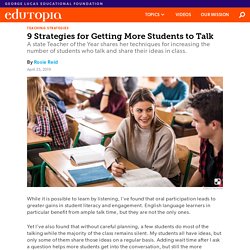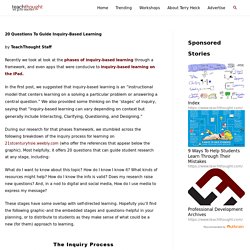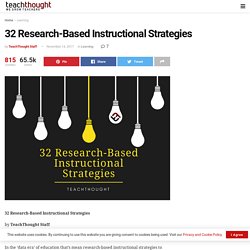

First visits 0. 9 Strategies for Encouraging More Students to Talk in Class. While it is possible to learn by listening, I’ve found that oral participation leads to greater gains in student literacy and engagement.

English language learners in particular benefit from ample talk time, but they are not the only ones. Yet I’ve also found that without careful planning, a few students do most of the talking while the majority of the class remains silent. My students all have ideas, but only some of them share those ideas on a regular basis. Adding wait time after I ask a question helps more students get into the conversation, but still the more confident students are more likely to raise their hands. Because of this, I pay close attention to who is participating in my high school English classroom and to the structures I’m using to promote participation. 9 Ways to Encourage More Students to Talk 1. 2. 3. They talk in their pairs from bell to bell between direct instruction about the topics of the day.
A List Of 50+ Teaching Strategies To Jumpstart Your Teacher Brain. Teaching strategies are among the most important ingredients for highly-effective learning environments.

In addition to literacy strategies, approaches to assessment, and grouping strategies (among many others), knowing the right teaching strategy for the right academic situation may not be a matter of expertise or training, but memory: out of sight, out of mind, yes? Which makes the following infographic from fortheteachers.org useful. While it doesn’t offer definitions and explanations for each strategy (it’s an infographic, not a book), and many great strategies are missing (e.g., 3-2-1, exit slip, project-based learning, accountable talk, ask a question, etc.) it does work well as a kind of reminder for what’s possible, even offering categories for each strategy, from progress monitoring (think-pair-share, KWL charts), to Note-Taking (graphic organizers).
There are 87 instructional strategies listed below, but several are repeated across categories, so let’s call it “50+” strategies. 13 Concrete Examples Of Better Feedback For Learning. 13 Concrete Examples Of Better Feedback For Learning by Grant Wiggins Below, find thirteen examples of how teachers have made feedback (as opposed to advice and evaluation) more central to their work with students: 1. In a welding class, the teacher gives students a performance task. The work is done when it is ‘up to professional welding standards’ for that type of weld. 2. 3. 4. 5. 7th-graders research and discuss the problem of pollution in science class. 6. 7. 5th-grade students are given challenging social studies tasks throughout the year. 8. 4th-graders take a math quiz on a computer, immediately find out which answers were correct and which incorrect once the quiz is completed, and work to correct the incorrect answers, using clues provided by the software. 9. 10. 11. 12. 13.
Readers: please place your own examples in the comments. Oh – and, of course, feedback is welcome! 20 Questions To Guide Inquiry-Based Learning. 20 Questions To Guide Inquiry-Based Learning by TeachThought Staff Recently we took at look at the phases of inquiry-based learning through a framework, and even apps that were conducive to inquiry-based learning on the iPad.

In the first post, we suggested that inquiry-based learning is an “instructional model that centers learning on a solving a particular problem or answering a central question.” We also provided some thinking on the ‘stages’ of inquiry, saying that “inquiry-based learning can vary depending on context but generally include Interacting, Clarifying, Questioning, and Designing.”
During our research for that phases framework, we stumbled across the following breakdown of the inquiry process for learning on 21stcenturyhsie.weebly.com (who offer the references that appear below the graphic). What do I want to know about this topic? These stages have some overlap with self-directed learning. References. 32 Research-Based Instructional Strategies - 32 Research-Based Instructional Strategies by TeachThought Staff You want to teach with what’s been proven to work.

That makes sense. In the ‘data era’ of education that’s mean research-based instructional strategies to drive data-based teaching, and while there’s a lot to consider here we’d love to explore more deeply, for now we’re just going to take a look at the instructional strategies themselves. A post is not the best way to share this kind of information, honestly. But upside to sharing this information as a post is that it can act a starting point to research the above, which is why we’ve tried to include links, related content, and suggested reading for many of the strategies, and are trying to add citations for all of them that reference the original study that demonstrated that strategy’s effectiveness.
How should you use a list like this? “In lieu of any problems, this much data has to be useful.